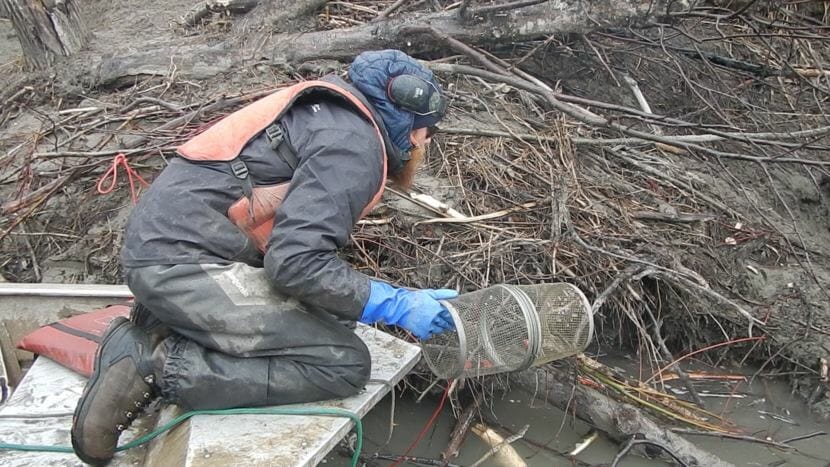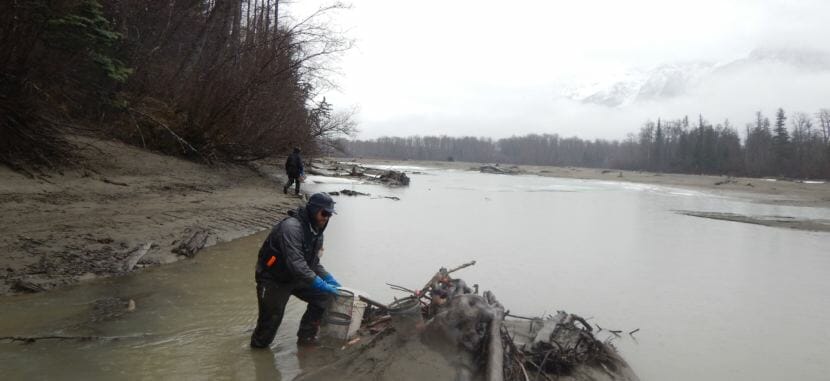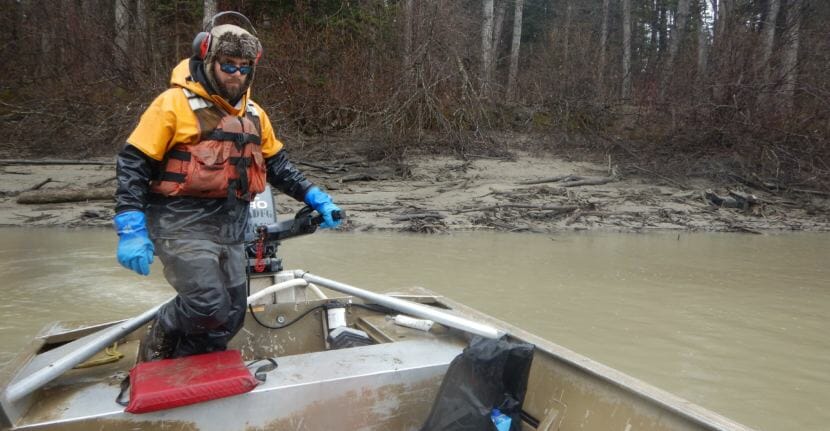
Fish don’t care about borders. But when it comes to sharing salmon, the lines on the map matter. That demands close cooperation between the U.S. and Canada to monitor the salmon that swim between Alaska and British Columbia.
The Taku is a transboundary river. It flows from British Columbia to Alaska. Its fish don’t notice the border and neither would Alaska Department of Fish and Game biologist Jeff Williams if it weren’t for a cement marker.
“As you can see from the monument, it says United States and on the opposite side of the monument it says Canada,” Williams said. “So technically, I don’t know, I’m in both countries.”
Each summer Alaska Fish and Game crews work with their Canadian counterparts to trap and tag wild salmon in this roadless area about 30 miles as the crow flies from Juneau.
The tag and recapture program is mandated by the Pacific Salmon Treaty. That’s the agreement that spells out how the U.S. and Canada share wild salmon stocks.
“It’s a joint project between the U.S. and Canada and the work that we do, we’re able to generate these estimates.” Williams said.

Those estimates are what’s used to manage commercial and sport fisheries between countries. Getting that data requires field crews from both countries working on both sides of the border.
Fish and Game’s James Bryant is checking smolt traps from the bow of a skiff.
“Each trap is just a matter of checking placement, re-baiting and checking for fish and putting them in the cooler and heading back to sort and tag them,” he said.
Tagging hatchery fish is common. But it takes a lot of effort to trap, tag and release wild salmon stocks. In just three or four years, some of these 3-inch smolt will swim back toward the the river where they hatched. After spending several years in the open ocean, the adults weigh an average of 10 to 30 pounds. Adult chinook are prized by anglers and commercial trollers alike for their beauty, value and taste.
Back at the smolt camp, the crew are assembled in a tarp-covered shack to tag the wild salmon caught that morning.
Joe Simonowicz carefully adjusts the tagging needle. If it doesn’t go deep enough the wire tag can fall out. Extend it too far and it’ll kill the 3-inch fish. Nobody wants that.
“You just hold them in there hit the button and the needle pops out and injects the tag,” Simonowicz said. “”It hardly leaves a mark or anything.”

The tags are pieces of wire, less than 2 millimeters-long. There are number codes only legible under a microscope. But this information will tell researchers which river and season the fish originated. A fin is also clipped so it’s obvious which salmon have been tagged.
Later in the season adults returning from the ocean are caught and checked for markers. Because biologists can estimate how many chinook left the river and eventually return as adults, they can estimate the species’ marine survival rate.
Right now it’s half of what it was a decade ago: about 1 percent.
“The production we’re seeing right now is the worst we’ve ever seen in Alaska,” said Ed Jones, who coordinates Fish and Game’s chinook salmon research. “We know how many smolt are going out. We know the numbers are good. They’re average or even above average, so it’s not a freshwater issue, this is a marine issue.”
The numbers recorded on the Taku are consistent with a larger trend.
Across Southeast, last year’s chinook runs were the lowest on record. This year’s projections were the poorest in agency history. That’s led fishery managers to cancel sport fishing openers and close commercial fisheries for king salmon across Southeast Alaska.
The wild tagging program doesn’t answer the question of why. Why are most of the 99 percent of chinooks perishing within months after they leave the river?

Jones said it allows biologists to rule out factors like fishing.
“What’s driving it is something that’s occurring at their first few months at sea,” Jones said. “But given that that is occurring and the rates of mortality are excessive right now, we have to pull the reins back on all the fisheries and pass as many fish as we can to the spawning grounds.”
Pulling back the reins means closed fisheries, something that’s been deeply unpopular among commercial fishermen across Southeast Alaska.
But researchers say they are hopeful things turn around soon. Later this summer Fish and Game will fly further into Canada to the headwaters of these rivers. There they hope to find young male salmon running up the river in force – the first clue that chinook stocks could be on the rebound.
Editor’s note: The Alaska Department of Fish and Game provided transportation for the reporter to the Taku River site.